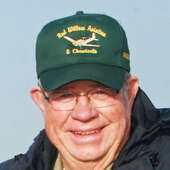- Sweatshirts, Jazzercise, and an unforgiving political climate (11/19/24)
- After the election: Lessons from history (11/5/24)
- Candy or cash: candidates and causes trick-or-treat for donations (10/29/24)
- You are fired! (10/1/24)
- Enduring heritage: Model Tís and Nebraskaís Unicam (9/24/24)
- YMCA project, coming changes and another attack (9/17/24)
- Class of '55 to share memories for Heritage Days (9/10/24)
Opinion
Drought or bust
Tuesday, August 14, 2012
Reflections from a "has been" farmer. The pastures are dried up, actually dormant, and crops have all failed. Doom is us. At least that seems to be the current feeling in the local area. The politicians push it so they can step in and throw money at the problem.
A closer look shows that things maybe aren't so bad as they look at first glance. For one the wheat crop appeared to be excellent, early this year but beating all expectations. The irrigated corn and soybeans look great except for the pivot corners which are mostly failed, dried up. Possibly that is due in part to planting too high a population of plants. Much of that failed crop seems to be getting cut for silage at the moment.
When one looks closely at the dry land fields of corn some appear to be completely failed and some show signs of drought but are hanging on and will make some crop. I can only attribute the difference to how well the fields have been managed. Was the stubble from the preceding crop kept weed free and left in place to preserve what moisture was available? Was the crop seeded to a population that was optimum for the variety planted and the moisture available? Weed free? Some farmers obviously have managed better than others.
It was interesting to drive to the eastern part of the state this past weekend. East of Grand Island I noticed that many of the corn fields were almost completely brown in color. Looking at the rows of healthy ears pointing down and full of grain told me that the plant was mature and the yield would probably be satisfactory. Soybean fields showed dry spots but were mostly filling pods and hanging on for the next rain. In the eastern part of the state a few farmers have installed center pivot irrigation systems and those corn and bean fields looked wonderfully good.
A dry year shows how important irrigation is to this area. Our average rainfall is marginal to produce consistent dry land crops. Those plants that prefer a Mediterranean climate like winter wheat seem to consistently do okay. Drought tolerant crops like milo, grain sorghum, fit our climate but don't generate the value per acre that corn does.
Corn was pretty much a bust on dry land until chemical till and residue management proved to conserve enough moisture to make a reasonable yield. Eco-fallow is the term that Bob Klein the agronomist who pushed the practice until it caught on with area farmers liked to use. Even so Bob predicted that two out of every seven years would probably be poor enough to not make expenses. Management was the key and it looks like this will be one of those poor years. It won't be a banner year but any manager worth his salt will carry enough crop insurance to cover his production expenses. Cattle on pasture and needing hay is a little tougher deal. The expense of pumping water will be extra high but $8 corn should ease some of that pain.
Your president and our favorite senator have been making noises about the bad old Republicans stalling the latest farm bill. The problem is that the farm bill has been combined with other larded-up spending bills that make the whole package so bad that every politician should vote against it. None of our Nebraskans did, and it is now stalled in the Senate. Let no good crisis go to waste!
It has been suggested that my readers might be interested in the information evolution that has taken place in the world of flight. Used to be pilots carried maps for navigation. Paper charts with terrain features that could be identified by air. Altitudes of obstacles like towers were portrayed along with navigation radio frequencies, airways and a hundred other bits of information tailored to the pilot's use. For making instrument approaches into larger airports, pilots carried booklets that portrayed the headings, altitudes for established routes to be flown to make a safe arrival through the clouds.
The world has changed. Paper charts are almost extinct. Pilots carry electronic devices, Apple's IPad is an example, which store and keep current all the charts that a pilot may need. Even shown on the electronic chart is the present position of the aircraft and one can see it move along the track as flight progresses. Weather, the same type of radar returns that we see on TV, is also portrayed, real time, so that the pilot can avoid the bad stuff. Even smart phones, seemingly carried by nearly every human now days, are capable of portraying weather conditions, similar to the TV weather, although not quite in the detail needed by pilots.
The electronic aids are fine, wonderful in fact, as long as they are working. Like all good things in life though electronic devices can fail, so it behooves each pilot to keep track of where he is and how to get to where he wants to go, even if the electrons quit. Keeping up with the rapidly evolving electronic devices in the aircraft is a challenge for this old pilot. When all else fails, though, I am thankful for the many hours of old school flying "by the seat of one's pants" that has been my privilege. That, too, is how I teach!
That is the way I saw it.

